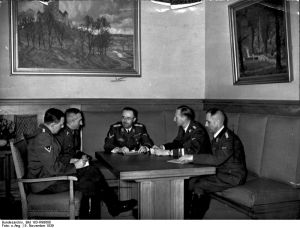Heinrich Müller

Heinrich Müller far right - Huber, Nebe, Himmler and Heydrich in Vienna
Heinrich Müller was born on the 28 April 1901, of Catholic parents. During the First World War he served as a flight leader on the Eastern Front and was awarded the Iron Cross-First Class. After the First World War ended in defeat for Germany, the ambitious Heinrich Müller made his career in the Bavarian police, specialising in the surveillance of Communist Party functionaries and making a special study of Soviet police methods. Partly because of his expertise in this field, he was selected by Reinhard Heydrich to be his closest associate and second-in-command of the Gestapo.
From 1935, the short, stocky Bavarian, with the square head of a peasant and a hard, dry, expressionless face, was the virtual head of the Gestapo, even though he was not a member of the Nazi Party. Müller was politically suspect to influential members of the Nazi Party, who resented his past record in the Munich State Police, when he had worked against the Nazis. Not until 1939, was he officially admitted into the NSDAP. Yet the stubborn, self-opinionated Müller was highly regarded by both Heinrich Himmler and Reinhard Heydrich, who admired his professional competence, blind obedience and willingness to execute 'delicate missions,' such as the elimination of leading army generals, as demonstrated by the Blomberg and Fritsch affairs, spying on colleagues, removing political adversaries without any scruples. Müller combined excessive zeal in his duties with docility towards his masters. He was the model of the cold, dispassionate Police Chief and a bureaucratic fanatic, and he was rapidly promoted by Heydrich, to the rank of SS Standartenfuhrer in 1937. He was subsequently promoted many times and he achieved the rank of SS-Obergruppenfuhrer on the 9th November 1941.
As the head of Amt IV in the Reich Main Security Office (RSHA) from 1939 until 1945, he was more directly involved in the 'Final Solution of the Jewish Question' than his superiors, for example he was Adolf Eichmann's direct chief. He signed the order requiring the immediate delivery to Auschwitz by 31 January 1943 of 45,000 Jews for extermination and countless numbers of other similar edicts. In the summer of 1943, he was sent to Rome, to put pressure on the Italians, who were proving singularly incompetent in arresting Jews for deportation to the East. Until the end of the war, Heinrich Müller continued his remorseless prodding of his subordinates to make greater efforts in sending Jews to Auschwitz. In his hands, mass murder became an automatic administrative procedure. He exhibited a similar streak in his treatment of Soviet Prisoners of War and he gave the order to shoot the British Prisoners of War who had escaped from Stalag Luft III in Sagan, Poland on the 24 March 1944.
Heinrich Müller's whereabouts at the end of the war are still shrouded in mystery. He was last seen in the Fuhrerbunker in Berlin on the 29 April 1945, after which he simply disappeared. Though his burial was recorded on 17th May 1945, when the body was later exhumed in 1963, it could not be identified. There were persistent rumours that he had defected to Eastern Europe, Moscow, Albania or East Germany, whilst other un-corroborated reports placed him in Latin America.

